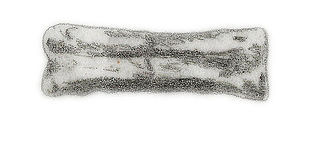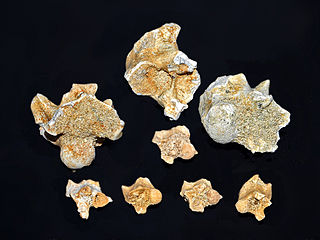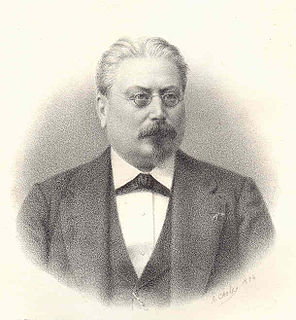
Teinurosaurus is a genus of carnivorous theropod dinosaur. Teinurosaurus lived during the Late Jurassic in what is now Portugal. The type species is Teinurosaurus sauvagei. It's been estimated to be 11.4 m in length and 3.6 tonnes in weight.

Neosodon was a genus of sauropod dinosaur from the Late Tithonian-age Upper Jurassic Sables et Gres a Trigonia gibbosa of Départment du Pas-de-Calais, France. It has never been formally given a species name, but is often seen as N. praecursor, which actually comes from a different animal. Often in the past, it had been assigned to the wastebasket taxon Pelorosaurus, but restudy has suggested that it could be related to Turiasaurus, a roughly-contemporaneous giant Spanish sauropod. It is only known from six teeth.

Erectopus is a basal allosauroid theropod from the Lower Cretaceous of France.
Teleosaurus is an extinct genus of teleosaurid crocodyliform found in the Middle Jurassic Calcaire de Caen of France. It was approximately 3 metres (10 ft) in length. The holotype is MNHN AC 8746, a quarter of a skull. Other fragmentary specimens are known. A single species, T. cadomensis, exists. It was previously considered a wastebasket taxon, with many other remains assigned to the genus.

Palaeophis is an extinct genus of marine snake that is the type genus of the extinct snake family Palaeophiidae.

The brown-tailed mongoose, Malagasy brown-tailed mongoose, or salano is a species of mammal in the family Eupleridae. It is endemic to Madagascar. Its natural habitat is subtropical or tropical dry forests. It is threatened by habitat loss.
Paramiacis is an extinct genus of Miacidae. Christian Mathis has defined to make a difference between the miacids from Europe and the American genus Miacis. There are two species of it, P. exilis and P. teilhardi - which were long believed to be only sexual dimorphism.

Quercygale is an extinct genus of Miacidae, primitive carnivores that lived during the Eocene. The genus contains four species: Q. angustidens, Q. hastingsae, Q. helvetica, and Q. smithi. Phylogenetic analysis of the basicranial morphology of miacid carnivoramorphans suggests Quercygale is the most advanced miacid and sister to crown group Carnivora, predating the split between Feliformia and Caniformia., although another recent study places them as a stem group within Feliformia.

Pachylemur is an extinct, giant lemur most closely related to the ruffed lemurs of genus Varecia. Two species are known, Pachylemur insignis and Pachylemur jullyi, although there is some doubt as to whether or not they may actually be the same species. Pachylemur is sometimes referred to as the giant ruffed lemur, because although it and the living ruffed lemurs had similar teeth and skeletons, Pachylemur was more robust and as much as three to four times larger. DNA studies have confirmed a sister group relationship between these two types of lemur. Like living ruffed lemurs, Pachylemur specialized in eating fruit, and was therefore an important seed disperser, possibly for tree species with seeds too large for even ruffed lemurs to swallow. In the spiny thickets of southwestern Madagascar, they were also likely to have dispersed seeds evolved to attach to fur and be carried away. Unlike ruffed lemurs, the fore- and hindlimbs of Pachylemur were nearly the same length, and therefore it was likely to be a slow, deliberate climber. However, both used hindlimb suspension to reach fruit on small branches below them.

Jules René Bourguignat was a French malacologist, a scientist who studied mollusks. He served as secretary-general of the Société malacologique de France. During his lifetime, he traveled widely, visiting, for example, Lake Tanganyika and North Africa. He reportedly defined 112 new genera and around 2540 new species of mollusks.
Robert Julien Hoffstetter was a French taxonomist and herpetologist who was influential in categorizing reptiles. He labeled the Bolyeriidae and Madtsoiidae family of snakes.

Palaeogale is an extinct genus of carnivorous mammal known from the Late Eocene, Oligocene, and Early Miocene of North America, Europe, and Eastern Asia. A small carnivore often associated with the mustelids, Palaeogale might have been similar to living genets, civets, and linsangs.

Helodermoides is an extinct genus of anguid lizards from the Oligocene of North America. The genus is monotypic, including only the species Helodermoides tuberculatus. Helodermoides belongs to an extinct subfamily of anguids called Glyptosaurinae. In addition to many fragmentary bones, several complete skeletons of Helodermoides are known. Like other glyptosaurines, Helodermoides was covered in small scale-like bones called osteoderms. The osteoderms covering its skull are hexagonal, tightly interlocking, raised, and rounded.

The Lignites de Soissonais is a geologic formation in the Var, Marne departments of France. It preserves fossils dating back to the Ypresian stage of the Eocene period.

The Quercy Phosphorites Formation is a geologic formation and Lagerstätte in Occitanie, southern France. It preserves fossils dating back to the Paleogene period, or MP16 to MP28 zones of the European land mammal age classification, ranging from approximately 38 to 25 Ma.
Tetracus is an extinct genus of hedgehogs. Species are from the Oligocene of Belgium and France. Fossils can also be found in the Bouldnor Formation in the Hampshire Basin of southern England.

Coniophis is an extinct genus of snakes from the late Cretaceous period. The type species, Coniophis precedes, was about 7 cm long and had snake-like teeth and body form, with a skull and a largely lizard-like bone structure. It probably ate small vertebrates. The fossil remains of Coniophis were first discovered at the end of the 19th century in the Lance Formation of the US state of Wyoming, and were described in 1892 by Othniel Charles Marsh. For the genus Coniophis, a number of other species have been described. Their affiliation is, however, poorly secured, mostly based on vertebrae descriptions from only a few fossils.
The Bulletin de la Société Géologique de France, otherwise known as BSGF - Earth Sciences Bulletin is a peer-reviewed open access scientific journal covering Earth sciences. The journal publishes articles, short communications, reviews, comments and replies. It is published by EDP Sciences and the editor-in-chief is Laurent Jolivet. The journal was established in 1830. It is a publication of the Société géologique de France. Most of the older content, published before 1924 is available online at the Biodiversity Heritage Library.
Stenoplacosaurus is an extinct genus of glyptosaurine anguid lizards from the Eocene of Inner Mongolia, China. The genus is monotypic, containing only the species Stenoplacosaurus mongoliensis.

The Silveirinha Formation is an Early Eocene geologic formation of the Mondego Basin in the Região Centro of central-western Portugal. The sandstones, siltstones and conglomerates were deposited in an alluvial environment.












